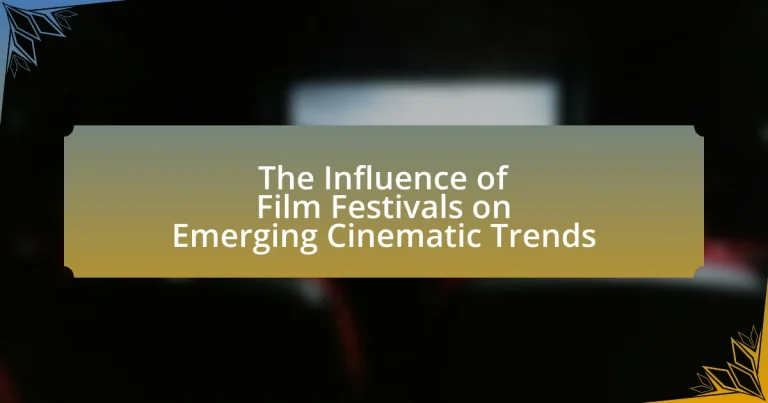Film festivals play a crucial role in shaping emerging cinematic trends by providing platforms for innovative storytelling, diverse voices, and new technologies. They influence the landscape of cinema by promoting independent films that challenge mainstream narratives and facilitate networking opportunities for filmmakers. Key trends highlighted at recent festivals include a focus on underrepresented voices, social issues, and the integration of technology in filmmaking. Additionally, festivals significantly impact audience perceptions and the visibility of unique films, ultimately driving the evolution of the film industry. The article explores these dynamics, emphasizing the importance of film festivals in fostering creativity and collaboration among filmmakers.

What is the Influence of Film Festivals on Emerging Cinematic Trends?
Film festivals significantly influence emerging cinematic trends by serving as platforms for innovative storytelling, diverse voices, and new technologies. These events showcase independent films that often challenge mainstream narratives, thereby encouraging filmmakers to explore unconventional themes and styles. For instance, the Sundance Film Festival has been pivotal in promoting films that address social issues, leading to a rise in socially conscious cinema. Additionally, festivals like Cannes and Toronto have introduced new cinematic techniques, such as virtual reality and interactive storytelling, which have gained traction in the industry. The exposure and recognition gained at these festivals can propel films into wider distribution, shaping audience preferences and industry standards.
How do film festivals shape the landscape of cinema?
Film festivals shape the landscape of cinema by providing a platform for diverse voices and innovative storytelling, which influences industry trends and audience preferences. These festivals, such as Cannes, Sundance, and Toronto, showcase independent films that often challenge mainstream narratives, thereby promoting new genres and styles. For instance, the rise of the “mumblecore” genre in the early 2000s gained traction through festivals, highlighting the importance of grassroots filmmaking. Additionally, film festivals facilitate networking opportunities for filmmakers, distributors, and critics, leading to increased visibility and potential funding for unique projects. This dynamic environment fosters creativity and experimentation, ultimately shaping the evolution of cinematic art.
What role do film festivals play in promoting new filmmakers?
Film festivals play a crucial role in promoting new filmmakers by providing a platform for their work to be showcased to industry professionals and audiences. These festivals often feature competitions specifically for emerging talent, allowing new filmmakers to gain visibility and recognition. For instance, the Sundance Film Festival has launched the careers of numerous filmmakers, with over 200 films from first-time directors being screened since its inception. Additionally, film festivals facilitate networking opportunities, connecting new filmmakers with producers, distributors, and other industry stakeholders, which can lead to future projects and collaborations. This support system is vital for new filmmakers seeking to establish themselves in a competitive industry.
How do film festivals influence audience perceptions of cinema?
Film festivals significantly influence audience perceptions of cinema by showcasing diverse narratives and innovative filmmaking techniques. These events provide a platform for independent and international films that may not receive mainstream distribution, thereby broadening viewers’ understanding of cinematic art. For instance, the Sundance Film Festival has been instrumental in introducing audiences to groundbreaking films like “The Blair Witch Project,” which altered perceptions of horror cinema and independent filmmaking. Additionally, film festivals often feature panel discussions and Q&A sessions with filmmakers, enhancing audience engagement and fostering a deeper appreciation for the creative process. This exposure to varied storytelling styles and cultural perspectives shapes how audiences interpret and value cinema as a whole.
Why are film festivals considered vital for cinematic innovation?
Film festivals are considered vital for cinematic innovation because they serve as platforms for showcasing diverse and experimental films that challenge traditional storytelling and production techniques. These events provide filmmakers with opportunities to present their work to audiences and industry professionals, fostering dialogue and collaboration that can lead to new ideas and approaches in filmmaking. For instance, festivals like Sundance and Cannes have historically introduced groundbreaking films that have reshaped cinematic narratives and styles, such as “Pulp Fiction” and “The Blair Witch Project.” By promoting independent and avant-garde cinema, film festivals stimulate creativity and encourage the exploration of unconventional themes, ultimately driving the evolution of the film industry.
What trends have emerged from notable film festivals in recent years?
Notable film festivals in recent years have seen a rise in the prominence of diverse storytelling, with a significant focus on underrepresented voices and global narratives. This trend is evidenced by the increasing number of films from female directors and filmmakers of color being showcased, such as at the Sundance Film Festival, which reported that 46% of its 2021 feature films were directed by women. Additionally, there has been a growing emphasis on social issues, with films addressing topics like climate change, racial injustice, and mental health gaining traction. The Cannes Film Festival has highlighted this shift by awarding films that tackle these themes, such as “Parasite,” which won the Palme d’Or in 2019 and sparked discussions on class disparity. Furthermore, the integration of technology in filmmaking, including virtual reality and interactive storytelling, has become more prevalent, as seen in the Tribeca Film Festival’s dedicated sections for immersive experiences. These trends reflect a broader evolution in the cinematic landscape, driven by the platforms and audiences that film festivals cultivate.
How do film festivals impact the types of films that gain visibility?
Film festivals significantly impact the types of films that gain visibility by providing a platform for independent and diverse filmmakers to showcase their work. These festivals often prioritize unique storytelling, innovative techniques, and underrepresented voices, which can lead to increased attention and distribution opportunities for films that might otherwise remain obscure. For instance, the Sundance Film Festival has been instrumental in launching the careers of numerous filmmakers and has historically highlighted films that challenge mainstream narratives, such as “The Blair Witch Project” and “Little Miss Sunshine.” This emphasis on diverse and unconventional films at festivals helps shape industry trends and audience preferences, ultimately influencing what types of films receive funding and distribution in the broader market.
What are the key characteristics of successful film festivals?
Successful film festivals are characterized by strong programming, effective marketing, and industry networking opportunities. Strong programming includes a diverse selection of films that appeal to various audiences, often featuring innovative and emerging filmmakers. Effective marketing strategies enhance visibility and attract attendees, sponsors, and media coverage, which is crucial for the festival’s reputation and success. Additionally, successful festivals facilitate networking opportunities for filmmakers, industry professionals, and audiences, fostering collaborations and discussions that can lead to future projects. These characteristics contribute to the festival’s ability to influence cinematic trends and promote new talent within the film industry.
How do programming choices affect the trends showcased at festivals?
Programming choices significantly shape the trends showcased at festivals by determining the selection of films that reflect current societal themes and artistic innovations. For instance, festivals like Sundance and Cannes often prioritize films that address pressing social issues, such as climate change or racial inequality, which influences the broader cinematic landscape by encouraging filmmakers to explore these topics. Data from the Sundance Institute indicates that films addressing social justice have increased in representation, reflecting audience demand and industry shifts. Consequently, programming decisions not only highlight emerging narratives but also set industry standards, guiding filmmakers toward trends that resonate with contemporary audiences.
What is the significance of awards and recognition at film festivals?
Awards and recognition at film festivals are significant as they provide validation and visibility to filmmakers and their works. This recognition can lead to increased distribution opportunities, funding for future projects, and enhanced credibility within the industry. For instance, winning prestigious awards like the Palme d’Or at the Cannes Film Festival can elevate a film’s profile, attracting wider audiences and critical acclaim. Additionally, awards often highlight innovative storytelling and diverse voices, influencing trends in cinema by encouraging similar thematic explorations and production styles among emerging filmmakers.

How do Film Festivals Connect with Emerging Cinematic Trends?
Film festivals connect with emerging cinematic trends by serving as platforms for showcasing innovative films that reflect current societal themes and technological advancements. These festivals often highlight new genres, narrative styles, and filmmaking techniques, allowing filmmakers to experiment and audiences to engage with fresh perspectives. For instance, the Sundance Film Festival has been instrumental in promoting independent films that challenge traditional storytelling, leading to the rise of the “mumblecore” genre in the 2000s. Additionally, festivals like Cannes and Toronto have spotlighted the integration of virtual reality and interactive storytelling, influencing industry standards and audience expectations. This dynamic interaction between festivals and filmmakers fosters a culture of creativity that drives the evolution of cinema.
What specific trends have been highlighted at recent film festivals?
Recent film festivals have highlighted trends such as the rise of diverse storytelling, increased focus on mental health themes, and the integration of technology in filmmaking. For instance, festivals like Sundance and Cannes have showcased films that prioritize representation across gender, race, and sexuality, reflecting a broader societal push for inclusivity. Additionally, films addressing mental health issues have gained prominence, with narratives that explore personal struggles and societal impacts, resonating with audiences and critics alike. Furthermore, the use of virtual reality and augmented reality in storytelling has been increasingly featured, demonstrating how technology is reshaping viewer experiences and engagement in cinema. These trends indicate a significant shift in the cinematic landscape, driven by both cultural movements and technological advancements.
How do technological advancements influence festival selections?
Technological advancements significantly influence festival selections by enabling more efficient submission processes and enhancing the accessibility of films. Digital platforms allow filmmakers to submit their works online, increasing the number of entries and diversifying the selection pool. For instance, festivals like Sundance and Tribeca have adopted online submission systems, leading to a broader range of films from various geographical locations. Additionally, advancements in streaming technology allow festivals to showcase films virtually, expanding audience reach and enabling participation from filmmakers who may not be able to attend in person. This shift has been evidenced by the rise of hybrid festival models, which combine in-person and online screenings, as seen during the COVID-19 pandemic. Such changes not only affect the logistics of festival operations but also shape the types of films that are selected, as festivals increasingly prioritize innovative storytelling that leverages new technologies.
What genres are gaining popularity through film festivals?
Horror and documentary genres are gaining popularity through film festivals. Recent trends indicate that horror films, particularly those that incorporate social commentary, have seen increased visibility and acclaim at festivals like Sundance and Toronto International Film Festival. Additionally, documentaries focusing on pressing social issues, such as climate change and human rights, are resonating with audiences and critics alike, leading to awards and distribution deals. For instance, the documentary “My Octopus Teacher” won the Academy Award for Best Documentary Feature after its success at various festivals, highlighting the genre’s growing prominence.
How do film festivals foster collaboration among filmmakers?
Film festivals foster collaboration among filmmakers by providing networking opportunities, facilitating partnerships, and encouraging co-productions. These events gather diverse industry professionals, allowing filmmakers to connect with peers, producers, and distributors, which can lead to collaborative projects. For instance, the Sundance Film Festival has been known to spark numerous collaborations, with many filmmakers forming alliances during the event. Additionally, festivals often host workshops and panels that promote knowledge sharing and skill development, further enhancing collaborative efforts. The collaborative environment created by film festivals is essential for the growth of emerging cinematic trends, as it encourages innovation and the exchange of creative ideas among filmmakers.
What networking opportunities do festivals provide for emerging talent?
Festivals provide significant networking opportunities for emerging talent by facilitating direct interactions with industry professionals, including producers, directors, and distributors. These events often feature panels, workshops, and Q&A sessions that allow emerging filmmakers to engage with established figures in the industry, fostering relationships that can lead to collaborations and mentorships. For instance, the Sundance Film Festival has been known to launch the careers of numerous filmmakers by providing a platform for them to showcase their work and connect with influential industry stakeholders. Additionally, networking events and social gatherings at festivals create informal settings where emerging talent can build connections, share ideas, and gain insights into the industry, enhancing their visibility and potential for future projects.
How do partnerships with industry stakeholders shape festival outcomes?
Partnerships with industry stakeholders significantly shape festival outcomes by enhancing resource availability, increasing visibility, and fostering networking opportunities. These collaborations often lead to improved funding, which allows festivals to attract higher-profile films and talent, thereby elevating the overall quality and prestige of the event. For instance, partnerships with major studios can result in exclusive premieres, drawing larger audiences and media attention. Additionally, industry stakeholders can provide valuable insights and trends that influence programming decisions, ensuring that festivals remain relevant and aligned with current cinematic movements. This dynamic interplay ultimately contributes to the festival’s ability to impact emerging cinematic trends and shape the future of the film industry.

What are the Future Implications of Film Festivals on Cinematic Trends?
Film festivals will increasingly shape cinematic trends by serving as platforms for diverse storytelling and innovative filmmaking techniques. As audiences and industry professionals gather at these events, they create a space for underrepresented voices and experimental narratives, which can influence mainstream cinema. For instance, the rise of streaming platforms has been accelerated by films that gained traction at festivals like Sundance and Cannes, showcasing how festival exposure can lead to broader distribution and audience engagement. Additionally, the emphasis on sustainability and social issues at festivals is prompting filmmakers to incorporate these themes into their work, reflecting a shift towards more socially conscious storytelling. This evolution indicates that film festivals will continue to play a crucial role in defining the future landscape of cinema.
How might film festivals evolve in response to changing audience preferences?
Film festivals may evolve by incorporating more diverse programming and interactive experiences to align with changing audience preferences. As audiences increasingly seek inclusivity and representation, festivals are likely to showcase a broader range of voices, including underrepresented filmmakers and genres. For instance, the rise of virtual and hybrid formats during the COVID-19 pandemic demonstrated that audiences appreciate accessibility and flexibility, prompting festivals to continue offering online screenings alongside in-person events. Additionally, data from the 2021 Sundance Film Festival indicated that 70% of attendees valued the option to participate remotely, highlighting a shift towards accommodating audience preferences for convenience and accessibility. This evolution reflects a broader trend in the entertainment industry, where audience engagement and satisfaction are prioritized to attract and retain viewership.
What role will digital platforms play in the future of film festivals?
Digital platforms will significantly enhance accessibility and audience engagement for film festivals in the future. By enabling virtual screenings and online interactions, these platforms allow festivals to reach a global audience, breaking geographical barriers that traditionally limited attendance. For instance, the 2020 Sundance Film Festival successfully utilized digital platforms, resulting in over 1.1 million views, showcasing the potential for wider audience participation. Additionally, digital platforms facilitate innovative marketing strategies and data collection, allowing festival organizers to tailor experiences based on audience preferences, thus driving future cinematic trends.
How can festivals adapt to the rise of streaming services?
Festivals can adapt to the rise of streaming services by incorporating hybrid models that combine in-person events with online streaming options. This approach allows festivals to reach a broader audience, as evidenced by the success of the 2020 Sundance Film Festival, which expanded its reach by offering virtual screenings alongside traditional in-person events, resulting in over 1.1 million views. By leveraging technology, festivals can enhance accessibility and engagement, ensuring that they remain relevant in a rapidly changing media landscape.
What best practices can emerging filmmakers adopt from film festivals?
Emerging filmmakers can adopt several best practices from film festivals, including networking, understanding audience engagement, and refining their storytelling techniques. Networking at film festivals allows filmmakers to connect with industry professionals, which can lead to collaboration opportunities and mentorship. Understanding audience engagement is crucial, as festivals provide insights into how different demographics respond to various genres and narratives, helping filmmakers tailor their projects for better reception. Additionally, refining storytelling techniques is essential; many successful films showcased at festivals highlight innovative narratives and unique perspectives, serving as valuable case studies for emerging filmmakers to analyze and learn from.
How can filmmakers leverage festival participation for career growth?
Filmmakers can leverage festival participation for career growth by gaining visibility, networking opportunities, and access to industry professionals. Festivals serve as platforms where filmmakers showcase their work to a diverse audience, including critics, distributors, and potential collaborators. For instance, the Sundance Film Festival has historically launched the careers of numerous filmmakers, with films like “The Blair Witch Project” and “Little Miss Sunshine” achieving significant commercial success after their festival debuts. Additionally, filmmakers can participate in panels and workshops at festivals, enhancing their skills and industry knowledge, which can lead to future projects and collaborations.
What strategies can filmmakers use to stand out at festivals?
Filmmakers can stand out at festivals by creating unique narratives that resonate with audiences and utilizing innovative marketing strategies. Unique narratives often involve fresh storytelling techniques or perspectives that challenge conventional norms, which can attract attention and generate buzz. For instance, films like “Moonlight” and “Parasite” gained acclaim for their distinctive storytelling and thematic depth, leading to significant recognition at festivals.
Additionally, filmmakers can leverage social media and targeted outreach to build anticipation and engage with potential viewers before the festival. A study by the University of Southern California found that films with active social media campaigns saw a 30% increase in audience turnout at screenings. By combining compelling content with effective marketing, filmmakers can enhance their visibility and impact at film festivals.


